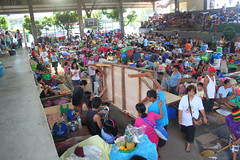 亞洲開發銀行在最新報告中提出警告,氣候變遷將在本世紀造成遷徙潮爆發,亞太幾個災害頻發國家必須要採取應對方案,以避免人道危機的發生。這份《因應亞太地區氣候變遷和人口遷徙》報告「是亞太地區第一份重量級報告,針對環境事件對人類移動的影響,指出該有的對策和因應作為。」
亞洲開發銀行在最新報告中提出警告,氣候變遷將在本世紀造成遷徙潮爆發,亞太幾個災害頻發國家必須要採取應對方案,以避免人道危機的發生。這份《因應亞太地區氣候變遷和人口遷徙》報告「是亞太地區第一份重量級報告,針對環境事件對人類移動的影響,指出該有的對策和因應作為。」
亞洲開發銀行副總裁羅哈尼(Bindu Lohani)強調,為了厚植亞太地區因應氣候變遷的「韌性」(resilient),「轉型」(transformational change)必不可免。
 先前曼谷水患已顯示出氣候變遷對亞太地區的衝擊,以及迅速採取行動的必要性。羅哈尼更以「迫切必要」來強調亞太國家必須加快努力以適應環境變遷所帶來的衝擊。他表示,我們現有的道路、下水道、橋梁及管線,有辦法抵禦氣候災害的(climate proof),相當不夠;更別說還有其他更多工作要做,像是強化資料收集、預警系統等等建構「氣候韌性社會」(climate resilient societies)所需的努力。
先前曼谷水患已顯示出氣候變遷對亞太地區的衝擊,以及迅速採取行動的必要性。羅哈尼更以「迫切必要」來強調亞太國家必須加快努力以適應環境變遷所帶來的衝擊。他表示,我們現有的道路、下水道、橋梁及管線,有辦法抵禦氣候災害的(climate proof),相當不夠;更別說還有其他更多工作要做,像是強化資料收集、預警系統等等建構「氣候韌性社會」(climate resilient societies)所需的努力。
羅哈尼表示,「公營融資機構與及私人投資者進行數十億美元的大型基礎建設投資時,不能再忽略全球暖化、海平面上升及暴風雨增強等現實因素。」
亞洲開發銀行此次報告便反映出了這項觀點,報告中指出「我們預計氣候變遷會增強天災發生的次數與強度,尤其是洪水、暴風與及熱浪。」
因此,報告中警告,氣候災難遷徙潮(climate change migration)是「一個急需政府及國際社會注意的新現象。」
亞銀在報告中表示,在亞太國家,氣候變遷調適的支出預計在2050年前達到400億美元,而即使目前有許多「環境基金」已設立,但還沒有一個是用來因應氣候遷徙問題的。
報告研究發現,在過去兩年,超過4200萬的亞太人口因天災而流離失所,這已是低估的是數字,還有一些人因遷徙而成移民、無法返家或找到安全的地方重建。
羅哈尼表示,「一些沿海低窪地區和河岸侵蝕面等脆弱地區的人口持續成長,對亞太地區來說,環境問題便成了人口遷徙的重要原因。」
他呼籲「政府不應該只是被動因應。現在就採取行動,便能減少受害程度,而加強韌性(恢復力),把遷徙當成適應氣候的方法、而非走投無路下的無奈選擇。」
氣候災難遷徙案例:
在巴布亞新幾內亞,海平面上升使得許多島上居民的生命陷入危險。2007年,當地政府和波西塔諾島政府決定,將巴國境內Carteret及其鄰近珊瑚礁島的居民重新安置於波西塔諾島。這項預防性重置居民的案例由非政府組織所協助,並且在特別安排下與當地居民進行協調。
 2010年,季風為巴基斯坦帶來暴雨,在印度河流域許多地區造成洪水,超過1000萬人流離失所,20%的國土被水淹沒,約2000人死於天災。報告指出,「普遍認為,國際援助的救濟提供並不夠,這次洪水為巴基斯坦和其人民帶來嚴重的傷忙,數以百萬計的農民居住於難民營,穀物和家畜遭破壞。」
2010年,季風為巴基斯坦帶來暴雨,在印度河流域許多地區造成洪水,超過1000萬人流離失所,20%的國土被水淹沒,約2000人死於天災。報告指出,「普遍認為,國際援助的救濟提供並不夠,這次洪水為巴基斯坦和其人民帶來嚴重的傷忙,數以百萬計的農民居住於難民營,穀物和家畜遭破壞。」
2011年12月,瓦西颱風在菲律賓的民答那峨島肆虐,超過30萬人流離失所,其中大部分在Cagayan de Oro 及 Iligan兩個都市。許多公共衛生問題因為缺乏適當的遷居設備而出現,需要立即地改善。
亞銀報告:正面看待遷徙潮
 上述報告是亞太地區第一份針對環境事件對人類移動的影響,指出該有的對策和因應作為。報告中提出了改善遷徙問題的國際條約、方針、原則及對話論壇。
上述報告是亞太地區第一份針對環境事件對人類移動的影響,指出該有的對策和因應作為。報告中提出了改善遷徙問題的國際條約、方針、原則及對話論壇。
對於往大都市遷徙所增加人口的容納問題,此報告建議,需增加投資至城市的基礎建設和基本服務。
報告同時也指出,保護遷徙權、保障遷徙人口公平享有教育、水源及衛生設施的必要性。
報告也提出建議,受氣候變遷威脅的社區,應改善其災害風險管理系統已加強其恢復力,如此可把人民流離失所的風險降到最小。並建議政府與民營企業合作,引進以海平面指標為基礎的保險、巨災債券、天氣衍生性商品等,以吸引投資者挹注資金,用於氣候變遷風險的融資與管理。
報告認為,氣候變遷所引起的人口遷徙不應僅視為對人類福祉的威脅,更是提升人類對氣候變遷適應力的工具。
Climate change will cause an upward surge in migration this century, and governments in disaster-prone Asia-Pacific nations must enact measures to stave off future humanitarian crises, warns a new Asian Development Bank report.
The report, "Addressing Climate Change and Migration in Asia and the Pacific," represents what the bank calls "the first significant effort to identify policy and other responses to impacts of environment events on human mobility within the Asia and Pacific region."
Nothing less than "transformational change" will be required to build societies in Asia and the Pacific that are resilient to climate change, Dr. Bindu Lohani, Asian Development Bank vice president emphasized.
Recent flooding in Bangkok has illustrated the impact of climate change on Asia and the Pacific and the need for urgent action. Lohani pointed to a "pressing need" for countries in the region to accelerate efforts to adapt to the impacts of climate change. Resources currently available to "climate proof" roads, sewers, bridges and pipelines are grossly inadequate, he said, and even more work is needed to improve data collection, early warning systems, and other activities vital to build climate resilient societies.
"Public lenders and private investors cannot continue to channel billions of dollars to massive infrastructure projects without factoring in the realities of warmer temperatures, rising sea levels and more violent storms," said Lohani.
The bank's report reflects this view, stating, "Climate change is expected to increase both the number and intensity of natural disasters, especially floods, storms, and heat waves."
As a result, the authors warn, climate change migration is "an emerging phenomenon requiring urgent attention by governments and the international community."
Climate adaptation costs for Asia-Pacific nations are estimated at $40 billion through 2050, and while there are environmental funds, none are currently dedicated to addressing climate-induced migration issues, the bank says in its report.
The report finds that more than 42 million people in the region were displaced by environmental disasters over the past two years. An undetermined number of those displaced people became migrants, unable to return home or choosing to relocate to safer ground.
"The environment is becoming a significant driver of migration in Asia and the Pacific as the population grows in vulnerable areas, such as low-lying coastal zones and eroding river banks," said Lohani.
"Governments should not wait to act," he urged. "By taking steps now, they can reduce vulnerability, strengthen resiliency, and use migration as an adaptation tool rather than let it become an act of desperation."
The report gives many examples of the climate-induced disasters that have displaced people in the region over the past several years.
In Papua New Guinea, sea-level rise is putting the livelihoods of many island communities at risk. In 2007, the Government of PNG, along with the autonomous government of Bougainville, decided to resettle inhabitants from the Carteret atoll and neighboring atolls to the island of Bougainville. This case of preventive resettlement is assisted by a nongovernment organization that has been specifically formed to coordinate with local people regarding their resettlement.
In July 2010, Pakistan was hit with heavy monsoon rains, which flooded much of the Indus River basin, displacing more than 10 million people, with about 20 percent of the country under water. About 2,000 people died in the disaster. According to the report, "The provision of international aid relief was widely considered as insufficient, and the floods took a very heavy toll on the country and its population, with millions of farmers housed in refugee camps, and crops and cattle destroyed."
In December 2011, Typhoon Washi ravaged the Philippines island of Mindanao and displaced more than 300,000 people, mostly in the cities of Cagayan de Oro and Iligan. Public health issues emerged as a result of the lack of adequate relocation facilities, which were urgently needed.
The report is among the first to identify policy responses to the impacts of environmental events on migration in Asia and the Pacific. The authors identify existing international agreements, guidelines, principles, and dialogue forums that can improve migration management.
To accommodate the anticipated increase in migrant flows to the regions megacities, the report recommends greater investments in urban infrastructure and basic services.
The need to protect migrant rights and to provide migrants with equitable access to education, health, water and sanitation is recognized in the report.
To minimize the risk of displacement, the report advises climate-threatened communities to strengthen their resilience by improving disaster risk management systems.
The report recommends that governments work with the private sector to introduce sea level index-based insurance, catastrophe bonds and weather derivatives to draw investors into financing and managing the risks posed by climate change.
It suggests that climate-induced migration should be seen not only as a threat to human well being but also as a tool to promote human adaptation to climate change.







